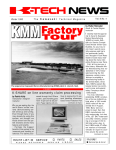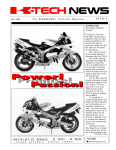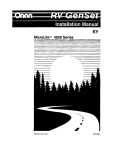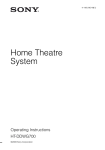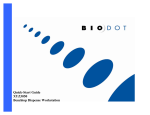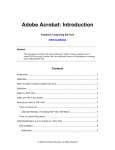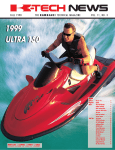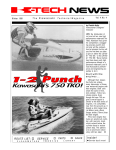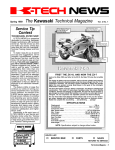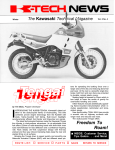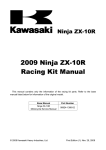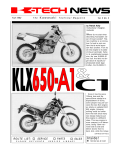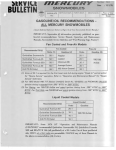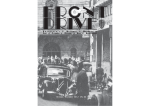Download K-Tech News Vol.3 No.1
Transcript
Spring 1990 The Kawasaki Technical Magazine Vol. 3 No. 1 Two Hot! Kawasaki’s advanced engineering has made overwhelming progress in the production of super performance oriented motorcycles possible. Proven technology and state-ofthe-art components are combined with innovative design in products that offer outstanding performance and handling, as well as added reliability. Two fine examples of motorcycles on the forefront of development for the ’90s are Kawasaki’s ZX1100-C1 (ZX-11) and ZX600-D1 (ZX-6). The ZX-11 is a supermodified ZX-10 with features that include forward-canted cylinders, free breathing valve train with forced-air induction, adjustable front forks and dual semi-floating fourpiston front calipers to name a few. All new for ‘90 is the ZX-6 boasting a new highcompression engine with microprocessor-controlled digital ignition, direct actuated valve train, downdraft carburetors, arced-air cylinder head cooling, front disc brakes with opposed four-piston calipers and a host of other hot features. Inside! n Inside the spectacular ZX-11 and ZX-6 (see pages 2 and 3) Plus. . . n Automatic video (see page 5) ROUTE LIST: o SERVICE P L E A S E R E T U R NT O o PARTS S E R V I C E o SALES L I B R A R Y S H O P T A L K / T E C H N I C A L The ZX-11: Performance matched only by durability by Jerry Heil Training Development Coordinator my of the motorcycle magazines and you’ll probably find some tidbits of information about the new ZX-11. For example, Cycle found that its horsepower at the rear wheel was 127bhp. Other magazines have reported astronomical top speeds and measured quartermile times in the low 10 second range. end hex driver (the same driver used on the ZX-10 and ZX750, special tool P/N 57001-1269) to the head of the drain screw. Attaching manometer hoses and adjusting linkage is also made easy. The ZX-11’s cylinder is rotated forward 17 degrees, but there’s still plenty of room for valve lash measurement. As on the ZX-10, the rocker arms slide sideways away from the valve. This allows easy replacement of the respectively. Its cams provide more duration for both intake and exhaust valves. The ZX-11’s eight additional horsepower and 3.7 more ft.-lbs. of torque require an increase in clutch capacity above that of the ZX-10’s clutch. The outer diameter of the steel driven plates is increased 5mm to 151 mm. Each of the eight driven plates is 2.9mm thick, where the ZX-10 KX models and provides more uniform friction characteristics and improved wear under heavy loads. The primary gear ratio on the ZX-11 is taller at 1.638:1 than the ZX-10’s 1.732:1. Transmission ratios are the same in both models, though the gears are different: The ZX-11’s increased power requires that second, third and fourth input gears, and second and Included in this article, though, are some details about this new bike that you may not have read about. The semi-downdraft 40mm Keihin carburetors do fit snugly between the perimeter frame rails. However, access to the float drain screws is easier than it looks. White plastic cones guide a 3mm ball- valve shims which are the same as those used on the ZX-10. The ZX-11 and ZX-10 have many engine parts in common including rocker arms, rocker shafts and springs as well as valve guides, valve springs and keepers. The ZX-11 intake and exhaust valves are 1.5mm and 1.0mm larger than those in the ZX-10 plates and six 2.6mm plates. The increase in clutch pack volume yields improved heat absorption capability and less clutch fade. The friction plates, meanwhile, use a paperbased compound instead of the cork compound used in the ZX-10. The paper compound has been used previously in made from a stronger steel alloy that contains nickel in addition to the chromium and molybdenum of the ZX-10 alloy. The ZX-11 continues the tradition of refinement in the Kawasaki ZX models. We are sure the ZX-11 will keep your customers happy with its unmatched performance and durability. o Read the latest issues of 2 l K-Tech News S H O P T A L K / T E C H N I C A L The ZX-6: Unmatched all-around performance by Patrick Kelly West Region lnstructor The Kawasaki ZX-6—officially, the ZX600-D1—is Kawasaki’s latest hightech weapon in the battle for top honors in the 600cc sport bike category. Kawasaki’s newest 0.6liter motorcycle has been created from the ground up, and has little in common with previous Kawasaki middleweights. The engine in the ZX-6 is completely new, producing more horsepower and torque than the ZXG00-C which preceded it and features a new fuel induction system. The airbox is 60 percent larger and feeds new 36mm downdraft-type carburetors that are a full 4mm larger than the conventional sidedraft carbs used on the C model. These larger carburetors help boost high rpm power output. The cylinder has also been canted forward 15 degrees and the overall downdraft angle is 49 degrees, giving the incoming air/fuel mixture a straight shot into the combustion chamber. This improves the breathing and provides quicker throttle response throughout the power band. The valve train is the direct actuation type, with replaceable shims for valve clearance adjustment. The intake valves use the same tappets as the ZX750-H, but the exhaust valves use a new, smaller tappet. The shims are a new type not used on any previous U.S. model so be sure to order a selection for your Service Department. Intake valve diameter has been increased from 21.5mm on the ZX600-C to 26mm on the ZX-6 while exhaust valve diameter has been increased from 19mm to 22mm. Valve stem diameter, meanwhile, has been reduced to 4.5mm on both intake and ex- new valves and the short stroke makes a 14,000rpm redline possible. Piston rings are new, too: The top and second rings are .2mm thinner at .8mm and the oil control ring is .5mm thinner at 1.5mm. Due to their lighter weight, these thinner rings are less likely to “flutter” at high rpm. Although the piston and rings are new, the piston pins and connect- haust valves. The included angle of the valves is a narrow 30 degrees, compared to 36.5 degrees on the ZX600-C. This makes possible a very compact pentroof-type combustion chamber allowing superior combustion efficiency. The large 64mm pistons result in a very oversquare 64mm x 46.6mm bore and stroke. The large bore makes room for the big ing rods are the same as in the ZX600-C engine. The ZX-6 engine does have a completely new crankshaft which turns in six plain-type main bearings; the ZX600-C has five main bearings. The increased horsepower output demanded improvements be made to the cooling and lubrication systems. The radiator and oil cooler are now the same as those found on the larger ZX750-F. The ZX-6 has coolant passages around the spark plugs and near the center of the exhaust ports. The cylinder liners are of the “open top deck type” which more effectively cool the upper portion of the cylinders. Cool air is also ducted from the front of the fairing to the top of the cylinder head to lower the air temperature around the engine. The improved lubrication system features two oil pumps, one supplying oil to the oil cooler and transmission gears, the other feeding pressurized oil to the engine. A new spin-on type oil filter completes the new lubrication package. A new, stronger clutch has been utilized on the ZX-6. Cable actuated, it is basically the same as in the ZX750-F except that the number of both drive and driven plates has been reduced by one. This allows the plates to be thicker, providing increased heat capacity and greater resistance to fade. The ZX-6 clutch also features a paper-based compound on the friction plates and has six damper springs with three different spring rates. All in all, the new ZX-6 engine and drivetrain package represents a giant leap forward in technology, resulting in a substantial increase in useable power. We believe the new engine is unmatched in its class for power and all-around performance. o The Technical Magazine l 3 G U E S T Spring 1990 Vol. 3 No. 1 © 1990 Kawasaki Motors Corp., U.S.A. (KMC). All rights reserved. K-Tech News Staff Publisher Kawasaki Tech Services Publications Manager Don Church Executive Editor Gary Herzog Editor-in-Chief Gregg Thompson Regional Editors North and East Fred DeHart Central and South Walter Rainwater West and Corporate Patrick Kelly Contributors Randy Davis, Bob Ellison, Jerry Heil, Donna Hood, “Micro” Mike Jeffers, Joe Nowocinski, John Porno, Steve Rice, Ray St. John, Bill Zito Graphics/Production Graphic Art Tim Bean, G. Thompson Copy Editor Pat Shibata Production Nickless Communications Published by Kawasaki. All suggestions become the property of KMC. Sending a service suggestion gives Kawasaki permission to publish and/or use it without further consideration. Specifications subject to change without notice. 4 l K-Tech News S P O T Motorcycle Mechanics Institute expands facilities and training on Kawasaki products by Don Church Manager, Service Training and Communications before, Kawasaki is now providing MMI with a steady stream of current product information. The mechanics. Dealers who are interested in interviewing or receiving resumes from these graduates school is using this to upgrade its programs to include better coverage of Kawasaki products. Graduates of MMl’s programs have proven to make excellent entry-level technicians who develop rapidly into solid line should call MMl’s graduate placement office in Phoenix at 1-800-5287995 or in Orlando at l800-342-9253. o Motorcycle Mechanics Institute, whose training programs have been endorsed by Kawasaki Motors Corp., U.S.A., is nearing completion of a new educational building on its Phoenix, Ariz., campus. When it’s finished, MMI will have 58,120 sq. ft. totally dedicated to motorcycle technician training. This state-of-the-art training facility includes 10 classrooms, 22 hands-on shops and three dynomometer test/training labs. Motorcycle Mechanics Institute, which has an eastern campus in Orlando, Fla., provides entry-level technician training on all types of motorcycles. As you may have read on these pages Photos this page: New construction on MMI's Phoenix campus. C O M M U N I C A T I O N S Automatic video? You bet! by Ray St. John Senior Technical Writer Kawasaki Heavy Indusries in Japan has an inlouse video studio and staff. KHI also has an ambitious program aimed at producing technical training video tapes covering he subjects most asked or by Kawasaki dealers in he U.S. Plans include the production of new-product introductory programs, such as the ZX-6 tape mentioned below. Here in this country, Kawasaki’s Service Training and Communications Department has develsped a new way for you to take advantage of this continuing effort. Now you can sign up to receive technical training video tapes automatically when they become available. Because we expect to lower our cost per copy by being able to produce more copies of each tape, we’ve recently lowered the price to you by 30 percent. It is now $25.00 plus applicable sales tax and shipping. This price break will be extended to cover all technical training tapes in our catalog for those dealers who sign on with the automatic program. We will send up to four tapes in a calendar year, but never more than four. So this program can never cost you more than $100 per calendar year. Plus, we understand that if you carry only JET SKI ® watercraft, you don’t want tapes on motorcycles. So we will send you only those tapes that cover the Kawasaki products you carry in your store. Frankly, we expect that you’ll like what you see, and you’ll decide to keep every tape we send. But, if you don’t want a tape after t’s been delivered automatically, just send it back or a full refund. If you have not already enrolled in the automatic video tape distribution program, here is another chance. All you have to do is fill out and mail in the postage-paid card bound into this issue. o If for any reason the postage-paid card is missing, send your address, including dealer number and authorized signature, to: Kawasaki Motors Corp., U.S.A., Tech Services Dept., 9950 Jeronimo Rd., Irvine, CA 92718, Attn: Automatic Video. The ZX-6, now playing on a VCR near you You’ve seen all the flyers; now, the new Introduction To ZX-6 Service video itself is finally here! The VHS-format ZX-6 video is actually two programs in one. Part one covers the innovative design and engineering of the ZX-6, explaining some of the manufacturing breakthroughs that make this incredible motorcycle available to-and affordable by— the knowledgeable motorcycle enthusiast. The second portion covers removal, disassembly, assembly and installation of the ZX-6 engine. This engine is entirely new and was designed from the ground up to have low overall weight and ultra-compact dimensions. As a result, many details differ from other Kawasaki engines (see Patrick Kelly’s feature on page 3 - Ed.). The ZX-6 videotape is paced for the experienced technician, but even a beginner can profit from watching it. If you haven’t already taken advantage of Kawasaki’s Automatic Tech Training Videotape Purchase Plan, fill out the coupon inserted into this issue. You’ll get this tape for only $25 plus applicable sales tax and shipping charges—30 percent off the regular dealer price of $35.95. - Ray St. John The Technical Magazine l 5 C O M M U N I C A T I O N S Microby “Micro” Mike Jeffers Parts Publications Specialist By the time this issue finds its way to you, all of the ’90-model microfiche will have been released. A convenient way of verifying that your Micro-K deck is up to date is to use the Micro-K Index as a reference. The date of issue on each microfiche (,,A” on illustration) should be the same as the date on the Index (“B”). Be sure to discard outdated fiche. To obtain individual replacement microfiche, order by part number (“C”). able for the KAF540-C1: Mule 2010 and KAF540D1: Mule 2020. You may order the catalogs by using P/N 99960-0031-01 (Mule 1000), 99960-003201 (Mule 2010) and/or 99960-0033-01 (Mule 2020). n We’re having a parts catalog clearance sale! Except for utility vehicles, Kawasaki has discon- n A transmission kit was added to the KAF450-B1: Mule 1000 microfiche (P/N 99961-0269) in February. (See the “Mule 1000 Transmission Improvement” article in the last issue.) Printed parts catalogs, meanwhile, are now avail- Servicing Your Bottom Line Right after Christmas, every Kawasaki motorcycle, ATV, and watercraft dealer in the country received a video tape entitled Servicing Your Bottom Line. The tape was sent out free of charge, and it was addressed directly to the dealer principal; “For Your Eyes Only” was the dramatic announcement on the outside of the package. Servicing Your Bottom Line was a special one-time effort, produced by Kawasaki’s Tech Services Department, urging all Kawasaki dealers to believe in the service end of their dealerships and their service personnel, and to let their dealerships grow in all aspects, including profitability. Many people worked hard to make this video a success, but the most important are the five dealers who appear in the tape. Our special thanks to these dedicated dealers—dedicated to their families, their employees, their communities and to the success of Kawasaki dealers all over the country. They gave us their time, opened their stores to us, let us use their people, gave us the benefit of their experience and encouraged us to produce what we believe to be an extremely worthwhile presentation. These dealers are: Mr. Ted Nielsen, Nielsen Enterprises, Lake Villa, Illinois Mr. Mike Whalley, Hooksett Kawasaki, Hooksett, New Hampshire Mr. Charles “Roc” Northey, Kawasaki of Lake Wales, Lake Wales, Florida Mr. Sammy White, Kawasaki City, Irving, Texas Mr. Patrick Cody, Wilson’s Kawasaki, Fresno, California - Ray St. John 6 l K-Tech News tinued production of printed parts catalogs. We still have limited quantities of some early model parts catalogs in stock, though, and we are offering them for sale at a clearance price of only $2.00 each. The catalogs listed will not be reprinted when present supplies are exhausted. Catalogs currently available are: 99995-625 JS400-A3 99910-1361-02 JS300-B2 99910-1365-03 JF650-A2 99960-0026-01 JS440-A6 99960-0028-50 JS550-A2 99960-2002 KG550A 99960-2022 GD700A 99960-2001 KG700, KG2600B 99960-2011 KG750B 99960-2012 KG1100B 99960-2005 KG1600A 99960-2016 GA1800A 99960-2006 KG2900A 99960-2018 GA3200A 99960-0030-01 KG5000A/AS 99910-1368-01 JS300-A1 99910-1372-01 JS440-A11 99960-0023-01 JS440A3, A4, A4A, A5 99960-0026-02 JS440-A7 39960-2021 GD550A 39960-2013 KG550B 39960-2023 GD700AS 39960-2003 KG750A 99960-2004 KG1100A 99960-2020 GA1400A 99960-2014 KG1600B 99960-2017 GA2300A 99960-2015 KG2900B 99960-2008 KG4000A/AS n As usual, if you have any questions, please call the Micro-K division of the Service Training and Communications Department at KMC, (714) 770-0400, ext. 2573, or fill out and send in the Micro-K report card (P/N M99994-152).o S H O P T A L K 1990 Team Green Race Preparation class by Jerry Heil Training Development Coordinator In the first three months it was offered, over 75 technicians took advantage of the information presented in Kawasaki’s new Team Green Race Preparation and Maintenance course. The class is two days packed with “how-to-do-it” and “‘where-to-find-it” information. Students receive printed step by step descriptions of engine race preparation techniques used by the same mechanics who prepared Larry Roeseler’s Baja-winning bike. The techniques are also demonstrated to the class by Team Green mechanics “‘fresh” from the prior weekend of competition. Operation of Kayaba inverted forks is explained in the text material, and fork service techniques are demonstrated in the classroom. Uni-Trak shock disassembly and assembly techniques are also covered in detail. The Team Green class student binder is worth its weight in work orders when you consider the valuable tips and reference materials it contains. The materials list includes ways to make inexpensive tools to get you started and plans for the more fancy ones when you have time. Were you one of the lucky 75 who signed up early, or are you being left behind? Reserve a seat in the next Team Green Race Preparation and Maintenance class at your Kawasaki Regional Training Center and stay ahead of the competition. o Instructors Erick Poston (left) and Pa trick Kelly (right) demonstrate service of inverted forks to West Region technicians. Service Department personnel requirements by Walter Rainwater, South & Central Region Instructor The single most important asset of any Kawasaki Service Department is its people. People reflect your operation. And the first impression of your service department is probably the most important; therefore, your service people are of prime importance to your dealership. Service employees should have a pleasant manner, be considerate of fellow employees and customers, have experience and knowledge of products serviced, and be competent in their positions. The attitude of your service staff will greatly influence the satisfaction of your customers. It is important that your employees have and maintain a good attitude. Some items that affect attitude are working conditions, fringe benefits, fairness in dealing with the employees and customers, work load, salary structures, etc. Monitor your service department, keep your employees busy, watch their attitudes, and you will make more money. Your service department has several different types of employees. The number will depend upon your shop size and may include service manager, service writer, line technician, specialist technician, assembly technician, apprentice technician and/or machinist. A service manager is recommended for all dealerships. In dealerships without a service manager, one person should be designated as lead technician. The lead technician performs the same duties as the service manager in addition to his duties as a mechanic. To prevent any misunderstandings about each employee’s responsibilities, you should write job descriptions-a different one for each position. Give a copy to each employee so he will know what is expected of him. It might look like the one below: Your service people are real assets. Treat them as such! o 0 JOB TITLE: Service Writer NAME OF SUPERVISOR: John Doe, Service Manager AREAS OF RESPONSIBILITY Maintain good customer relations. Promote the dealership and its product lines. SPECIFIC DUTIES: Customer contact. Greet customers in a friendly, courteous manner. Sell services offered by the dealership. Write repair orders completely and realistically. Assist technicians in diagnosing problems by recording all pertinent information on repair orders. Solicit follow-up business by contacting previous customers via telephone or mail. . . The Technical Magazine l 7 T I P S F R O M T H E S P E C I A L I S T S Have the correct information ready I t is very important when calling the Hot Line to have all the correct vehicle information ready. Model number, frame number, mileage and failure date are all required. Remember that “Ninja 1000” and “KLR650” are not precise model designations but ZX1000-B3 and KL650-A4 are. Also, all California models are identified with an “L” as the last character (for example, ZX1000-B3L). When we ask for the “frame number”, we need only the last sixdigits of the VIN for motorcycles and ATVs, and the first five numbers (after “KAW” or “JKA”) of the HIN for watercraft. If you have all this information ready each time you call, you’ll spend less time on the phone with the Hot Line staff. And so will we, which means less time for you on “hold” waiting for one of us to answer. - John Pomo Police Motorcycles: Turn signal cancelling problems By Bill Zito, National Police Motorcycle Coordinator If your local police agency has encountered repeat failures of the automatic turn signal cancelling device in the LH handlebar switch assembly, this may be of help: The failure can be caused by holding the turn signal switch in the “ON” position after the control unit has activated the solenoid in the switch assembly to cancel the turn signal. Holding the switch ON overloads a small solid-state “fused link” in the solenoid and burns it out. The solenoid can be made operational again if you bypass the fuse. Follow the service manual procedure to verify that the cancelling device in the LH switch assembly is the problem and then perform the following surgery on the solenoid. Start by taking the switch assembly off the handlebar. The cancelling mechanism is contained in the bottom half of the case. To get at it, you’ll need to remove three small screws, two on the outside and one inside the housing. Lift the mechanism out. The solenoid unit is wrapped in white plastic tape. Carefully cut and open this tape on the underside, opposite the white/green wire. Do not disturb the tape on the side where the white/green wire is attached. Once the tape has been opened, you will find a small fused link in the ground wire. This tiny fuse has failed causing an open in the coil circuit. Bypass this fuse by soldering a jumper wire around it. After installing the jumper wire, cover this area with electrical tape and re-install the cancelling mechanism in the switch housing. The nice thing about this repair is that it will probably be the last one of its kind for that vehicle. o 8 l K-Tech News New carb syncro tuner Kawasaki is proud to introduce its new carb syncro tuner, a high quality mercury manometer used to synchronize carburetors on all two-and fourcylinder Kawasaki fourstroke engines. This new tool is made of high impact plastic and has a large, easy-to-read scale printed right on the case. Hoses, mercury and instructions are included. Order yours today; it is P/N T56019-031B. -Joe Nowocinski T I P S F R O M T H E S P E C I A L I S T S Hot Fuses: Corrosion or current flow Occasionally the Hot Line will get a call about an older machine with a “hot fuse box”. Sometimes the fuse will get so hot the solder melts out of it. One cause of overheated fuses, especially in older bikes, is dirty or corroded fuse mounting clips. The poor connection caused by the dirt or corrosion may cause arcing at that point and excessive heat. To correct the problem, remove the fuse and clean and tighten the contacts. You may need to use fine grit wet/dry sandpaper; contact cleaner works well on dirt and oil, but it won’t remove corrosion. If, after cleaning the contacts, the fuse is still getting too hot, check the current flow through the fuse. The amperage load might be very near the rating of the fuse. If so, the fuse element is getting hot and is probably near the melting point. Check the load of individual components downstream of that fuse to find the cause of the overload. Usually you’ll find the overload is caused by some added, non-original equipment. - Bob Ellison JS550 compression: what’s OK, what’s not Something technicians sometimes overlook when dealing with a “hard starting” problem on a JS550 JET SKI ® watercraft is compression. In fact, when hard starting is a symptom with any engine, compression should be checked; however, with the JS550 you might think compression is OK when it’s really not. The 550 engine is not a high compression engine-a good-running stock boat will have only 120-130psi cranking pressure. You might think it’s OK, then, with only 105psi. After all, that’s less than 20 percent down from a really sharp stock engine. In fact, for late model engines, the range given in the service manual is 78-112psi. In reality, if a JS55O’s engine compression dips below 110psi, starting will be affected. This is especially true for ’86 and later models. Reduced ignition advance and other modifications make the newer boats more sensitive to low compression. If you’re working on a JS550 that is hard to stat-l and it has compression below 110psi, check ring wear (end gap) and cylinder condition. If those are in spec, check cylinder length. A few “long” cylinders that cause low compression have shown up in the field. If you have a cylinder that measures longer than 116.25mm, gasket surface to gasket surface, call the Hot Line. - Gregg Thompson Consumer Services: What you don’t say is important When dealing with customers, what you don’t say may be just as important as what you do say. For example, don’t say: “It can’t be done.” Instead, diffuse a customer’s anger by saying: “I’ll see what I can do.” If you must later give the customer a negative answer, at least he will appreciate your efforts to solve his problem. If you are at all uncertain about the warranty status, tell the customer you will discuss the situation with Kawasaki to see if warranty consideration can be given. Giving this type of response can lessen the customer’s dissatisfaction and soften the news of denied warranty. Be sure to follow through on your promise to discuss the situation with KMC, and call the customer back as quickly as possible concerning the decision. Procrastination and excuses when handling warranty decisions and complaints will result in angry customers. - Donna Hood, Consumer Services The Technical Magazine l 9 T I P S Which crankshaft? The first JF- and JS650 crankshafts were located in the cases by a dowel pin in the center seal. Since then the design has been changed twice. If you are ordering either a crankshaft or crankcases for a 650 JET SKI ® watercraft, be very careful to order the correct one by engine number. If you are ordering both cases and crankshaft, it’s probably best to order the latest part numbers. Once again, select the part numbers off the microfiche carefully. For your information, the first design (with the dowel pin in the center seal) is superseded by a second design which has a half-circle retaining ring in the front center main bearing. Both crankcase and crankshaft retain the dowel pin hole for compatibility with the earlier parts. The third design has a thinner, full-circle retaining ring in the front center main bearing. This is not compatible or interchangeable with either of the earlier designs unless the crankshaft and cases are replaced as a set. - Gregg Thompson 10 l K-Tech News F R O M T H E S P E C I A L I S T S Cold seizure: Too much too soon Have you ever heard of a cold seizure? Does “cold seizure” sound like a contradiction in terms? Maybe it won’t after a short explanation.... When a cold seizure occurs, it’s not the piston that is cold; it’s the cylinder. In all engines, the piston heats up (and expands) quicker than the cylinder. In liquid-cooled two-stroke engines, this unequal rate of expansion is far greater than in other engine designs. The cold liquid in the water jackets draws the heat from the cylinder material more quickly than an air cooled design and a two-stroke— firing every time the piston comes up-can rapidly heat up the piston. A problem occurs when the engine is run too hard before it is completely warmed up and the piston outgrows the cylinder bore. "Four corner" pattern. A cold seizure is usually easy to identify because of its unique “four corner” pattern. The piston’s expansion isn’t perfect and becomes slightly square as it’s heating up. The highest points on the piston (where it will contact the cylinder first) are usually near the outer edges of the intake and exhaust skirts (see illustration). Thus, the “four corner” seizure pattern. There’s no doubt today’s liquid-cooled twostroke engines provide unequalled performance and light weight, but you do have to be careful warming them up. - Gregg Thompson KX125/250 CDI test values The KX125-H1 and KX250-H1 CDI ignition systems can be tested with the Kawasaki CD Ignition Tester (P/N T56019-201). The test values and meter connections are as follows: - Fred DeHart The Hot Line number: A dealer exclusive! At the risk of seeming like we’re beating a dead horse, we must ask you again to remind all of your dealership personnel not to give the Product Support Hot Line num- Steve Rice ber to customers. Having a customer call the Hot Line significantly affects our ability to handle the calls from your service department, especially during the busy season. When a customer gets hold of a technician at Kawasaki (on a toll free number no less), he usually doesn’t want to let go. And since we don’t want to be rude to the customer, the call is seldom a short one. While we’re talking to the customer, your technician and the problem he’s having must wait. In addition, calling the Hot Line can add to the customer’s frustration-and he may have been frustrated to start with: He calls one number only to be referred to another (Consumer Services). The Hot Line staff wants to help customers. But we can do this best by giving the dealer the best technical assistance possible as quickly as possible. We hope it doesn’t come to this but if the customer’s problem cannot be solved at the dealership, he should be referred to Kawasaki Consumer Services, not the Product Support Hot Line. Illustration - Gregg Thompson WEST CONTlNUED FROM PAGE 12 you may have, it is always possible to learn something new. Generally, the students in all the classes have a wide variety of experience and backgrounds. By participating in discussion and sharing your thoughts and ideas, you’ll be assured of learning something new. Coming to class well prepared makes it possible to take full advantage of the training courses offered by Kawasaki, and maximizes your learning potential. Next time you attend, make the most of it and remember the Boy Scout motto: Be Prepared! Patrick Kelly, 9950 Jeronimo Road, Irvine, CA 92718, (714) 770-0400. SOUTH & CENTRAL CONTINUED FROM PAGE 12 date for your dealership personnel to attend. Our Spring schedule concludes at the end of May. Enroll now in the Team Green Race Preparation class or other class of your choice! Walter Rainwater, 6110 Boat Rock Blvd. S. W., Atlanta, GA 30378, (404) 349-2000. NORTH & EAST CONTlNUED FROM PAGE 12 Fred DeHart, 201 Circle Drive N., #107, Piscataway, NJ 08854, (201) 469-1221. The right sealant for the job When sealing the center cases of any motorcycle or watercraft engine, make sure to use a sealant that is highly gas and oil resistant. Most sealants labeled “silicone sealant” are not oil resistant at all. In some cases, they can actually create a leak that may not have occurred if you didn’t use any sealant. These sealants soften rapidly when exposed to oil or gas and provide a sort of “wick”, a path connecting inside to outside for the oil to follow. The only sealant Kawasaki recommends for engines is the white Kawasaki Bond (P/N 56019-120). It is very expensive so don’t waste it. For sealing engine center cases, a very thin, almost transparent, coat on the sealing surfaces is all that’s needed. A good way to apply the sealant without wasting any is to use a small (¼-inch or so) paint brush. Kawasaki Bond is manufactured by Three Bond Co., Ltd. of Japan. Other gas and oil resistant sealants are available from: Three Bond of America, Inc., 20815 Higgins Court, Torrance, CA 90501, (213) 320-3342. - Randy Davis The Technical Magazine l 11 R E G I O N A L N E W S Training Schedule East Region April 24-26 JET SKI ® Watercraft 27 Product Update May 8 9-11 14 15 Parts Department Operations JET SKI ® Watercraft JET SKI ® User Relations Wkshop Service Department Operations (K-BOSS) 16-17 Team Green Race Preparation 18 Product Update North Region April 18-19 Team Green Race Preparation May JET SKI ® User Relations Wkshop Service Department Operations (K-BOSS) Parts Department Operations 22 23-24 Team Green Race Preparation 25 Product Update 3 21 WEST SOUTH & CENTRAL NORTH & EAST Come to class prepared Team Green Race Prep Update your skills by Patrick Kelly by Walter Rainwater by Fred DeHart In order to get the most When this issue of Because of some un- from time spent at your regional training center, it helps to come to class well-prepared. Here are a few suggestions: Review the subject matter before coming to class. Write a note listing those items which are well understood and those items which are unclear to you. Be sure to write down any questions you have beforehand, just to make sure you remember to ask them. Get a good night’s rest before coming to class. If you are traveling a long distance, try to arrive early enough the day before class starts to assure a good night’s sleep. This will help you to remain alert and attentive throughout the day. Come to class with an open mind, ready to learn. No matter what level of knowledge or experience K-Tech News arrives, you will still have an opportunity to pre-register and attend our new Team Green Race Preparation class. We introduced this class because of dealer requests and have held it several times. Technicians that have attended have been very complimentary about the class’ content. As with many of our training classes, even the most experienced technician can learn something new and helpful. Some of the tips can make their jobs easier and quicker; others, including this particular Team Green Race Prep class, may help prevent some expensive damage from occuring while doing routine service. Have a look at the training schedule on this page of the newsletter, and select a class and usually mild weather patterns, service work has been brisk at many dealerships in the North and East Regions early in this new decade of the ’90s. By now, your service department should have received the Technical Training bulletins outlining the class schedule through May. If you are planning to attend classes, sign up now before the weather breaks and you find you’re too busy to go. “He who hesitates will miss the opportunity.” Our new Team Green Race Preparation and Maintenance class has been very well received by those who have attended. This is a good time to take advantage of the season and update your skills on the new KX motocross machinery. I hope to see you at one of our classes soon! CONTlNUED ON PAGE 11 12 l K-Tech News CONTlNUED ON PAGE 11 CONTlNUED ON PAGE 11 Central Region April 30 JET SKI ® User Relations Wkshop May 1 2 3-4 Product Update Team Green Race Preparation JET SKI ® Watercraft South Region April JET SKI ® High Performance 19 23-26 Troubleshooting Electrical Systems May High Performance Engines 7 8-9 Team Green Race Preparation Product Update 10 11 JET SKI ® User Relations Wkshop 14-16 JET SKI ® Watercraft JET SKI ® High Performance 17 21 Product Update 22-24 Troubleshooting Electrical Systems West Region April 19 20 20 30 Service Department Operations (K-BOSS) JET SKI ® User Relations Wkshop Product Update High Performance Engines May 1-2 3 7 8-9 10 Troubleshooting Electrical Systems Product Update Generators Team Green Race Preparation Service Department Operations (K-BOSS) 14-16 JET SKI ® Watercraft Product Update 17 29-30 Engines High Performance Engines 31












